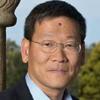Precourt Institute Affiliated Faculty
Affiliates of the Precourt Institute play an active role in the interdisciplinary energy community that is the foundation of energy research and teaching at Stanford. Their personal research and expertise in energy is listed below. Many of them also engage in research not related to energy, which is not described here. Names link to Stanford employee directory listings. Terms for filtering under “Energy Research Area” are divided into categories provided in capital letters, e.g. “END USE/EFFICIENCY” “ENVIRONMENTAL IMPACTS,” and “POLICY & ECONOMICS.” Users can filter for specific areas or the entire category.
Please send comments and suggestions to: mark.golden@stanford.edu.
Department/Research Program:
Education, Stanford Woods Institute for the Environment
Energy Research Area:
Buildings, Energy & Behavior, Transportation
Developing a community-based program for reducing residential energy use, working with Girl Scouts. Environmental learning and behavior, including transportation.
Department/Research Program:
Economics
Energy Research Area:
Finance & Subsidies, Tax & Regulation
The implications of discounting and uncertainty for climate and energy policy.
Department/Research Program:
Carnegie - Global Ecology, Earth System Science
Energy Research Area:
Climate, Land Use
Impacts on local ecology of biofuel expansion. Impacts on climate of using more land for biomass energy. Regional impacts of climate change and energy policy in the Western Hemisphere.
Department/Research Program:
Energy Resources Engineering
Energy Research Area:
CO2 Capture, Storage & Conversion, Enhanced Oil Recovery, Natural Gas, Unconventional Oil & Gas
Models for predicting performance of conventional and non-conventional hydrocarbon reservoirs (including shale oil and gas), and CO2 sequestration operations. Flow of complex mixtures (oil, gas and water) in porous rocks and in pipes. Optimization of oil field development and operations.
Department/Research Program:
Communication
Energy Research Area:
Energy & Behavior
Using avatars and virtual reality simulations to reduce energy use through reexamination of personal energy behavior and by connecting specific energy use and environmental consequences.
Department/Research Program:
Civil & Environmental Engineering
Energy Research Area:
Nuclear
Probabilistic and statistical tools for modeling the reliability of nuclear power plants and nuclear waste repositories.
Department/Research Program:
ChangeLabs
Energy Research Area:
Buildings, Energy & Behavior
Developing human-centered, online programs to motivate residents to reduce energy consumption, using social norms and goal setting as motivators.
Department/Research Program:
Chemical Engineering
Energy Research Area:
Batteries & Fuel Cells, CO2 Capture, Storage & Conversion, Bioenergy, Photovoltaics
Synthesis of functional organic and polymer materials for numerous energy applications, such asnanostructured polymers for low-cost, stretchable batteries and PV cells, and thin-film organic PV cells. Printable, electrically conductive gel for potential use in energy storage and biofuel cells.Nitrogen-doped porous carbon for CO2 capture.
Department/Research Program:
GSB - Economics
Energy Research Area:
Energy & Behavior, Management & Innovation
Dynamic effects of bans on fluorescent light bulbs on consumer decision making, lighting manufacturers, interactions between consumers and firms, and technological innovation.
Department/Research Program:
Energy Resources Engineering, Global Climate & Energy Project, Precourt Institute
Energy Research Area:
Climate, CO2 Capture, Storage & Conversion
Sequestering CO2 in deep underground formations. Permeability of CO2 and brine, especially sensitivity to injection flow-rate and various fluid properties. Net energy analysis of emerging technologies, such as PV and energy storage.Energy systems analysis to guide decisions about providing energy while reducing GHG emissions.
Department/Research Program:
Chemical Engineering, TomKat Center for Sustainable Energy
Energy Research Area:
Batteries & Fuel Cells, Photovoltaics, Renewable Fuels
Understanding and controlling surface and interfacial chemistry, and materials synthesis. Applying this to new materials and processes for next generation low-cost solar cells, fuel cells and catalysts.
Department/Research Program:
Geological & Environmental Sciences
Energy Research Area:
Geothermal
Accelerating the conversion of CO2 into carbonate minerals that can be sequestered in silicate rocks rich in magnesium and calcium. Chemical and physical processes of geothermal systems.
Department/Research Program:
Electrical Engineering
Energy Research Area:
Electric Grid
Decentralized message passing to constantly optimize an electricity network with many different devices, each with its own complex constraints and objective.
Department/Research Program:
Energy Resources Engineering
Energy Research Area:
Climate, CO2 Capture, Storage & Conversion, Natural Gas, Unconventional Oil & Gas
Reducing the environmental impacts of energy systems. Methane leaks from US natural gas system. Analysis of CO2 capture technologies. Life-cycle analysis of transportation fuels. Modeling global oil depletion, or "peak oil," and transitions to oil substitutes.
Department/Research Program:
Materials Science & Engineering
Energy Research Area:
Photovoltaics
Development of silicon-based microphotonic functionality and plasmonic devices to manipulate the flow of light at the nanoscale. Use of nanowires in thin-film solar cells to boost efficiency.
Department/Research Program:
Management Science & Engineering
Energy Research Area:
Management & Innovation
Entrepreneurship education regarding high-growth and technology enterprises, in particular energy-related technologies.
Department/Research Program:
Carnegie - Global Ecology, Earth System Science
Energy Research Area:
CO2 Capture, Storage & Conversion, Climate, Wind
Transition from coal to low-carbon electricity. Oceanic CO2 sequestration. Accounting for CO2 emissions. Future CO2 from existing energy infrastructure. High-altitude wind power. Assessing wind power resources. Geoengineering to combat climate change.
Department/Research Program:
Aeronautics & Astronautics, Mechanical Engineering
Energy Research Area:
Combustion, Water, Transportation
New, fast burning fuels for application to hybrid propulsion. Nitrous oxide as a propellant for small space thrusters. Energy-neutral biological sewage treatment.
Department/Research Program:
Mechanical Engineering
Energy Research Area:
Batteries & Fuel Cells, Combustion, Solar Thermal, Transportation
Plasma propulsion. Plasma and combustion synthesis of materials. Effects of injecting ionized gas on the operation of a fuel cell. Photon-enhanced thermionic emission devices, which use solar heat and light.
Department/Research Program:
Chemistry, SLAC - Stanford Synchrotron Radiation Lightsource
Energy Research Area:
Batteries & Fuel Cells, Renewable Fuels
Electron transfer between electrodes and among redox species. Electrocatalysts to convert CO2 and feedstocks to higher value materials. Water oxidation with metal-oxide semiconductor anodes.
Department/Research Program:
Materials Science & Engineering, Precourt Institute
Energy Research Area:
Batteries & Fuel Cells, Renewable Fuels
Fundamental and applied electrochemistry: solar fuels, fuel cells, and batteries.
Department/Research Program:
Civil & Environmental Engineering
Energy Research Area:
Water Systems, Bioenergy
Creating valuable products from organic waste streams. Turning wastewater treatment into a producer of energy instead of a consumer. Using anaerobic bacteria to convert organic waste to methane gas for fuel to convert wastewater to drinking water. Biosynthesis and molecular-scale recycling of bioplastics and biocomposites. In-situ remediation of radioactive waste.
Department/Research Program:
Materials Science & Engineering, SLAC - Photon Science
Energy Research Area:
Batteries & Fuel Cells, Electric Grid, Grid Scale Storage, Bioenergy, Photovoltaics
Fabrication of nanoscale materials, and study of their electronic, photonic, electrochemical and catalytic properties. Applications include lithium ion batteries, supercapacitors, CIGS solar cells, transparent electrodes and using carbon nanotubes in microbial fuel cell electrodes.
Department/Research Program:
Chemistry
Energy Research Area:
Batteries & Fuel Cells, Renewable Fuels
New ways to synthesize graphene and carbon nanotube architectures for potential future device applications, such as fuel cells, catalysis, and lithium-air and nickel-metal batteries. Tungsten disulfide nanoflakesas a catalyst for producing hydrogen from water.
Department/Research Program:
Materials Science & Engineering
Energy Research Area:
Batteries & Fuel Cells, Photovoltaics, Solar Thermal
Characterizing and modeling the fundamental micromechanical and photochemical mechanisms that dictate the reliability and lifetimes of emerging energy technologies, including solar cells and their modules, PEM fuel cells, and batteries.
Department/Research Program:
SLAC - Photon Science, Stanford Institute for Materials & Energy Science
Energy Research Area:
Batteries & Fuel Cells, Photovoltaics, Superconductors
Modern computational approaches to electron and photon dynamics. Models for new energy paradigms for developing novel materials for superconductors, photovoltaics and batteries.
Department/Research Program:
Earth System Science, Stanford Woods Institute for the Environment
Energy Research Area:
Climate, Land Use, Energy Markets
Interactions between climate change, biofuel mandates, and energy and agriculture markets. Interactions between climate and large-scale solar energy projects.
Department/Research Program:
Materials Science & Engineering
Energy Research Area:
Grid Scale Storage, Photovoltaics
Nanostructured materials for light manipulation, photovoltaics and photocatalysis. Converting low energy photons to higher for greater efficiency in solar cells. Hydrogen absorption and desorption in individual palladium nanocrystals
Department/Research Program:
Applied Physics, Physics, SLAC - Photon Science
Energy Research Area:
Batteries & Fuel Cells
Self-assembly of nanostructures from the natural protein clathrin to act as templates for metallization, which could potentially be of interest as experimental battery electrodes.
Department/Research Program:
Energy Resources Engineering
Energy Research Area:
CO2 Capture, Storage & Conversion, Enhanced Oil Recovery, Natural Gas
Computational modeling of subsurface flow, with applications in oil and gas production and geological carbon sequestration. Optimization of subsurface flow operations and energy systems.
Department/Research Program:
Mechanical Engineering
Energy Research Area:
CO2 Capture, Storage & Conversion, Combustion, Transportation
Efficient, low-polluting transportation engines (piston and turbine) by taking reactants to extreme states of energy density, and advanced electric generation. Sootless diesel engine. Coal-fired power with CO2 capture via combustion in supercritical saline aquifer water.
Department/Research Program:
Biology, Carnegie - Plant Biology
Energy Research Area:
Bioenergy
Study of plant cell wall biogenesis, cellulose synthase dynamics and trafficking, for potential application to cellulosic biomass for energy.
Department/Research Program:
Biology
Energy Research Area:
Climate, Land Use
The population-resource-environment crisis, including a revision of humanity's energy systems, energy's effect on biodiversity, and the potential for reduction in energy consumption.
Department/Research Program:
Electrical Engineering
Energy Research Area:
Electric Grid
A simulation tool that models all parts of the electrical network, including generation, transmission, intermittent renewable supply, energy storage, distributed generation and electrical vehicles.
Department/Research Program:
Economics, Center on Food Security & the Environment
Energy Research Area:
Bioenergy, Economic Development & Equity, Climate, Land Use
How different scenarios of expanded biofuels production in rich and poor countries will affect global and regional food prices, farmer incomes, food consumption by the poor, and climate.
Department/Research Program:
Electrical Engineering
Energy Research Area:
Photovoltaics, Solar Thermal, Transportation
Photonic band gap materials and nanoscale photonic devices. Thermophotovoltaics. Control of thermal radiation. Nanostructured solar cells. Wireless charging of electric cars.
Department/Research Program:
Biology, Carnegie - Global Ecology, Earth System Science
Energy Research Area:
Climate, Land Use, Bioenergy
Integrating large-scale solar projects with biofuel production in deserts. Impacts on climate of converting land use from food to biofuel crops. Climate benefits of converting biofuel crops from annual plants to perennials. Global potential of bioenergy.
Department/Research Program:
Civil & Environmental Engineering, Precourt Energy Efficiency Center
Energy Research Area:
Buildings
Virtual design and construction.
Department/Research Program:
Applied Physics, SLAC
Energy Research Area:
Transportation
Trip estimation techniques to better manage hybrid vehicle batteries. Energy interests in transportation systems, energy efficiency and education of scientists and non-scientists in energy policy and technology.
Department/Research Program:
Biology, Carnegie - Plant Biology
Energy Research Area:
Bioenergy
Key mechanisms for distributing energy in plants and fine tuning biomass. Cellulose production - polymer synthesis and extrusion. Nitrogen efficiency--reducing fossil fuels in making fertilizers.
Department/Research Program:
SLAC - Photon Science
Energy Research Area:
Renewable Fuels
Electron transfer dynamics. Mechanisms for directed and efficient channeling of solar energy to chemical energy. Multi-exciton generation efficiency in nano-structured materials.
Department/Research Program:
Applied Physics
Energy Research Area:
Superconductors
Research leading to superconductors with higher transition temperatures and improved current carrying capability that can improve the generation and transmission of electrical energy.
Department/Research Program:
Mechanical Engineering
Energy Research Area:
Transportation, Combustion
Using control systems to reduce the environmental impact of automobiles. Unmanned electric vehicles. Homogeneous charge compression ignition engines.
Department/Research Program:
Energy Resources Engineering
Energy Research Area:
Enhanced Oil Recovery, Solar Thermal
Models to predict the performance of enhanced oil recovery methods, particularly gas injection and in-situ combustion. Improved siting of large-scale concentrating solar power projects.
Department/Research Program:
Mechanical Engineering
Energy Research Area:
Air Quality, Climate, Combustion, Transportation
Chemical kinetics, such as determination of bond dissociation energies. Rate constants for reactions of OH with fuels. Optimization of synthetic oxygenated fuels. Hydrogen effects on climate, stratospheric ozone and air pollution.
Department/Research Program:
Physics
Energy Research Area:
Superconductors
Behavior of electrons confined to nanostructures. Tuning electronic and optical properties of materials and nanostructures using electrolyte gating, to optimize materials for energy conversion.
Department/Research Program:
Electrical Engineering
Energy Research Area:
Electric Grid
Big data analytics for asset management. Risk-adjusted forecasting of electric power load. Systems and controls analysis of power systems with distributed generation.
Department/Research Program:
Economics, Hoover Task Force on Energy Policy, Stanford Environmental & Energy Policy Analysis Center
Energy Research Area:
Energy Markets, Law, Tax & Regulation
The environmental and economic impacts of U.S. and international environmental policies, including policies to deal with climate change, and with pollution from power plants and automobiles. Strengths and weaknesses of a carbon tax. Design of cap-and-trade systems. Obama administration's "Clean Power Plan."
Department/Research Program:
Mechanical Engineering
Energy Research Area:
Batteries & Fuel Cells, CO2 Capture, Storage & Conversion, Renewable Fuels
Electrochemical energy conversion, and storage materials and processes. Fuel cells for methane, hydrogen and solid fuel conversion. CO2 and water electrolysis for energy storage (methane). Coal-fired fuel cell with CO2 capture.
Department/Research Program:
Mechanical Engineering
Energy Research Area:
Combustion, Transportation
Development of laser-based diagnostics to optimize performance and minimize pollution of combustion and propulsion systems. Synthetic oxygenated fuels. Sensors for advanced combustion. Rate constants for reactions of OH with fuels.
Department/Research Program:
Electrical Engineering
Energy Research Area:
Green Computing, Photovoltaics
New materials for electronic and optoelectronic devices. Low-cost, thin-film solar using III-V compound semiconductors including III-nitrides. Tiny, highly efficient semiconductor lasers for low-energy data interconnects.
Department/Research Program:
Materials Science & Engineering
Energy Research Area:
Economic Development & Equity, National Security
Managing the global expansion of nuclear power while avoiding the proliferation of nuclear weapons, with special attention to the nuclear aspirations of states such as North Korea and Iran.
Department/Research Program:
Materials Science & Engineering
Energy Research Area:
Batteries & Fuel Cells
Self-assembly of nanostructures from the natural protein clathrin to act as templates for metallization, which could potentially be of interest as experimental battery electrodes.
Department/Research Program:
Energy Resources Engineering
Energy Research Area:
Enhanced Oil Recovery, Unconventional Oil & Gas, Geothermal
Geothermal, oil and gas reservoir engineering. Energy production optimization. Enhanced geothermal systems. Well test interpretation. Tracer analysis of fractures.
Department/Research Program:
Electrical Engineering
Energy Research Area:
Green Computing
Developing energy efficient electronic solutions. Circuit, architecture and application optimization tools to minimize energy needed for each task. Applications from server farms to imagers in mobile platforms.
Department/Research Program:
Materials Science & Engineering
Energy Research Area:
Batteries & Fuel Cells, Grid Scale Storage
Overview of advanced batteries. New types of long life, safe and inexpensive alkali metal batteries to connect wind and solar sources to the electrical grid. Hydrogen transport and hydride formation in metals, alloys and intermetallic compounds for use in vehicular fuel cells and batteries.Materials and phenomena in lithium-ion batteries.
Department/Research Program:
GSB - Operations, Info. & Tech.
Energy Research Area:
Electric Grid
New tools for making decisions in complex operational settings. Optimizing power dispatching for energy utility networks in the presence of uncertain demand and supply.
Department/Research Program:
Civil & Environmental Engineering
Energy Research Area:
Air Quality, Climate, Integrated Modeling, Wind
Developing large-scale clean, renewable energy solutions to global warming, air pollution and energy security. Modeling energy's effects on health and climate. Quantifying wind, water, and solar energy resources and reducing the impacts of their intermittency. Potential damping effect of large, ocean-based wind farms on hurricanes.
Department/Research Program:
Chemical Engineering, SUNCAT Center for Interface Science & Catalysis
Energy Research Area:
Batteries & Fuel Cells, CO2 Capture, Storage & Conversion, Renewable Fuels
Tailoring solid-state surfaces for effective catalysis in both the production and consumption of energy. Developing devices for storing renewable electricity based on chemical transformations. Converting CO2 and water into sustainable fuels and chemicals. Tools include nanoparticles, metals, alloys, sulfides, nitrides, carbides, phosphides, oxides, and biomimetic organo-metallic complexes.
Department/Research Program:
Management Science & Engineering
Energy Research Area:
Electric Grid, Energy Markets
Design and management of the electric grid. Model and analyze efficient market mechanisms for resource allocation on the grid, using tools from operations research, engineering and economics.
Department/Research Program:
Chemistry
Energy Research Area:
Renewable Fuels
Producing ethanol from carbon monoxide gas with a copper catalyst. Electrochemical CO2 and nitrogen gas reduction. Oxide-derived metal nanoparticle catalysts.
Department/Research Program:
Applied Physics, Physics
Energy Research Area:
Superconductors
Understanding mechanisms for high-temperature superconductors. Novel phases and phase transitions in disordered and strongly correlated electron systems. Micro- and nano-scale mechanical devices
Department/Research Program:
Chemistry
Energy Research Area:
Batteries & Fuel Cells, Nuclear, Photovoltaics
Materials for the reversible sequestration of pollutants and for electro- and photo-catalytic conversions relevant for clean energy. Capturing atmospheric CO2 using organic-inorganic hybrid materials.
Department/Research Program:
Economics
Energy Research Area:
Energy Markets
Impact of emission permits on electricity generation. Multiunit auctions, including those for electricity, in which buyers submit discrete bids and hence their demands are step functions.
Department/Research Program:
Electrical Engineering
Energy Research Area:
Buildings, Green Computing
Green energy-efficient networks. Green networks for office and residential buildings. Novel photonics for green networks. Energy efficiency in optical and wireless access networks.
Department/Research Program:
Chemical Engineering, Chemistry
Energy Research Area:
Bioenergy
Genetically engineering E. coli bacteria to increase production of fatty acids, or biodiesel, from a biological matter feedstock for use as a transportation fuel.
Department/Research Program:
Psychology
Energy Research Area:
Energy & Behavior
Neural mechanisms that support emotion and decision making. Consumer decision making when purchasing major appliances and effects of nudges like eco labeling.
Department/Research Program:
Steyer-Taylor Center for Energy Policy & Finance
Energy Research Area:
Climate, Green Computing
Long-term trends in the energy-efficiency of computing. Economics of efficient data centers. Analysis of climate mitigation strategies.
Department/Research Program:
Civil & Environmental Engineering, Stanford Woods Institute for the Environment
Energy Research Area:
Water Systems, Climate, Land Use, Water
Environmental fluid mechanics. Turbulence and internal wave dynamics in stratified flows. The transport of mass and energy in estuarine systems such as San Francisco Bay.
Department/Research Program:
Political Science
Energy Research Area:
Public Opinion
Surveys documenting public beliefs about global warming and preferences for energy policy for more than 15 years. Monitoring and interpreting processes of opinion formation and change.
Department/Research Program:
Aeronautics & Astronautics, Electrical Engineering
Energy Research Area:
Electric Grid
Control technologies for networked and distributed systems, including the electric system. Impact on power grid reliability from widespread use of distributed energy resources.
Department/Research Program:
Computer Science, Electrical Engineering
Energy Research Area:
Green Computing
Emerging computer systems, such as low-power wireless sensor networks and full duplex wireless.
Department/Research Program:
Civil & Environmental Engineering
Energy Research Area:
Buildings, Management & Innovation
Ways for the construction industry to overcome barriers to adopting energy-efficient innovations. Designing organizations and governance regimes for sustainable development of energy and civil infrastructure projects.
Department/Research Program:
Materials Science & Engineering, SLAC - Photon Science
Energy Research Area:
Photovoltaics
The speed limits and microscopic processes that determine the performance of devices for energy conversion. Ultrafast properties of nanoscale materials.
Department/Research Program:
SLAC, Stanford Institute for Materials & Energy Science
Energy Research Area:
Superconductors
Angle-resolved photoemission spectroscopy studies of strongly correlated electron systems, in particular the high temperature superconductors.
Department/Research Program:
Mechanical Engineering
Energy Research Area:
CO2 Capture, Storage & Conversion, Solar Thermal
With core expertise in fluid dynamics, computational engineering, and electrokinetic phenomena, we investigate a concept idea for improving efficiency of plasma-based CO2 converters.
Department/Research Program:
Physics, Stanford Institute for Materials & Energy Science
Energy Research Area:
Green Computing, Superconductors
Atomic and molecular manipulation for energy-efficient nanotechnology. Designer materials and nanoelectronics. Local response of novel superconductors. Carbon-based devices.
Department/Research Program:
Civil & Environmental Engineering
Energy Research Area:
Buildings, Economic Development & Equity, Electric Grid, Photovoltaics, Wind
Analysis, design and evaluation of energy efficiency and renewable energy technologies,as keys to slowing global warming, enhancing energy security and improving conditions in underserved, rural communities. Green buildings. Wind and solar electricity. Distributed energy systems.
Department/Research Program:
Earth System Science
Energy Research Area:
Air Quality, Climate, Water, Land Use, Natural Gas, Economic Development & Equity
Energy in the context of sustainability. Balancing water and energy demands.
Department/Research Program:
Materials Science & Engineering
Energy Research Area:
Batteries & Fuel Cells, Photovoltaics
Thin films, especially complex metal oxides. Metal-oxide semiconductor anodes for oxidation of water. Low-to-intermediate temperature solid oxide fuel cells. Multijunction nanowire solar cells.
Department/Research Program:
Mechanical Engineering
Energy Research Area:
Batteries & Fuel Cells, Bioenergy
Coal-based power generation involving coal conversion in supercritical water with CO2 capture and aquifer-based sequestration. Coal and biomass utilization in solid oxide fuel cells with CO2 capture. Co-firing coal and biomass during combustion and gasification. Chemical looping combustion with coal and biomass. Coal and biomass conversion in supercritical water for production of liquid fuels.
Department/Research Program:
Applied Physics, Physics
Energy Research Area:
Superconductors
Specialized magnetic nanoprobes. Magnetic signatures of materials with quantum mechanical and strongly correlated electron behavior. Single vortex dynamics in superconductors.
Department/Research Program:
Computer Science
Energy Research Area:
Buildings
Energy disaggregation software, which separates a whole-home meter signal into appliance-level data, to help residents reduce energy use through finer understanding of their consumption.
Department/Research Program:
SLAC - Photon Science, SUNCAT Center for Interface Science & Catalysis
Energy Research Area:
Batteries & Fuel Cells, Grid Scale Storage
For fuel cells, elucidating the steps of the oxygen reduction reaction to overcome power losses at the cathode and finding new catalysts to replace platinum. Carbon nanotubes for hydrogen storage.
Department/Research Program:
Chemical Engineering, SLAC - Photon Science, SUNCAT Center for Interface Science & Catalysis
Energy Research Area:
Batteries & Fuel Cells, CO2 Capture, Storage & Conversion, Bioenergy, Renewable Fuels
Understanding interface phenomena, including adsorption, surface chemical reactions, heterogeneous catalysis, and photo- and electro-catalysis. Applications include solar fuel production, syngas reactions, biomass conversion, fuel cells, and battery processes.
Department/Research Program:
Civil & Environmental Engineering
Energy Research Area:
Management & Innovation, Tax & Regulation
Transfer of wind turbine energy technologies. Liquefied natural gas facility siting in the US.
Department/Research Program:
Electrical Engineering
Energy Research Area:
Photovoltaics
Extending silicon device structures to nanoscale dimensions. Rapid melt growth method to transform amorphous to single crystal for III-V solar cells on bulk silicon substrates.
Department/Research Program:
Computer Science, Electrical Engineering
Energy Research Area:
Energy & Behavior, Sensors & Data, Transportation
Using incentive mechanisms and societal networks for reducing congestion-related costs in transportation, both public and private.
Department/Research Program:
Materials Science & Engineering, Mechanical Engineering
Energy Research Area:
Batteries & Fuel Cells, Photovoltaics
Quantum confined solar cells, including quantum dots, thin barrier layers and transparent electrodes. Solid oxide fuel cells. Photosynthetic membranes and their catalytic behavior.
Department/Research Program:
Communication
Energy Research Area:
Buildings, Energy & Behavior, Sensors & Data
Creation of a multiplayer game platform linked to home energy sensors to enable empirical research about how serious games can change consumer decisions about energy consumption.
Department/Research Program:
GSB - Economics
Energy Research Area:
Energy Markets, Management & Innovation, Tax & Regulation
Quantifying the impacts of energy and environmental institutions and policies. Auction design on electricity markets. Impacts of carbon policies on energy intensive industries. Restrictions on incandescent light bulbs.
Department/Research Program:
GSB - Accounting
Energy Research Area:
Finance & Subsidies, Tax & Regulation
Cost competitiveness of renewable energy sources, including solar PV, wind and biofuels. Economics of CO2 capture by fossil fuel power plants. Design of alternative regulatory and subsidy mechanisms to achieve CO2 reductions.
Department/Research Program:
Steyer-Taylor Center for Energy Policy & Finance
Energy Research Area:
Finance & Subsidies, Law, Tax & Regulation
Using master limited partnerships and real estate investment trusts to encourage renewable energy investment through fairer taxation. Using energy cost information in calculating terms of building mortgages.
Department/Research Program:
Applied Physics, SLAC - Photon Science
Energy Research Area:
Photovoltaics, Superconductors
Nonequilibrium phonon dynamics. Thermal transport across interfaces between dissimilar materials. Fundamental laser-matter interactions in solids in the high-field limit.
Department/Research Program:
Hoover Task Force on Energy Policy, Precourt Institute, Program on Energy & Sustainable Development, SLAC
Energy Research Area:
Climate, Energy Markets, Integrated Modeling, Nuclear
Global energy system analysis. Energy policy and energy supply issues.Nuclear energy. Reliability versus cost trade-offs in wind energy investments in California.Science policy.
Department/Research Program:
Pediatrics
Energy Research Area:
Buildings, Energy & Behavior, Transportation
Applying experimental approaches from public health and medical research to develop family-, school-, and community-based interventions to promote residential, transportation and food-related energy-saving behaviors. Designing "stealth interventions" that harness the motivating characteristics of social movements to promote the overlapping goals of environmental sustainability and health.
Department/Research Program:
Materials Science & Engineering
Energy Research Area:
Photovoltaics
Structure/property of crystalline and polymeric organic semiconductors for photovoltaics. Upconverting nanomaterials. Advanced characterization of materials.
Department/Research Program:
Applied Physics, Physics, SLAC
Energy Research Area:
Batteries & Fuel Cells, Superconductors, Solar Thermal, Renewable Fuels
High-temperature cuprate and pnictide superconductors. Photon-enhanced thermionic emission devices, which use solar heat and light. Transition metal oxides as functional energy materials. Multi-scale imaging of energy materials. Diamondoids-nanostructured diamond.
Department/Research Program:
Hoover Task Force on Energy Policy, Precourt Energy Efficiency Center, Precourt Institute
Energy Research Area:
Nuclear, Finance & Subsidies, Law, Management & Innovation, National Security, Tax & Regulation
U.S. energy policy and its effects on domestic and international political priorities, national security, the economy and global climate. Proposal for a revenue-neutral tax on carbon. Results of low-carbon energy research at U.S. universities. Making nuclear power safer globally, both in terms of accidents and nuclear weapons proliferation.
Department/Research Program:
Hoover Task Force on Energy Policy
Energy Research Area:
Law, National Security
Nuclear energy and weaponry proliferation, particularly in Iran. Securing Israel's offshore natural gas resources.
Department/Research Program:
Electrical Engineering
Energy Research Area:
Solar Thermal
Material processing and fabrication technology for solar concentrators based on graded-index and optical meta-materials to improve output and lower cost in thermal solar and photovoltaic cells.
Department/Research Program:
Chemistry, SLAC - Photon Science
Energy Research Area:
Batteries & Fuel Cells, Renewable Fuels
Determining the electronic structure of transition metal complexes, which are utilized in oxidation catalysis and fuel cells to facilitate and control oxygen activation and reduction. Hydroxylation of methane (and other simple hydrocarbons) using copper and iron to produce methanol, which could reduce oil dependence and GHG emissions.
Department/Research Program:
Chemical Engineering
Energy Research Area:
Batteries & Fuel Cells, Photovoltaics
A mathematical model for charge transport in semiconducting polymers for insights into the limits of charge mobilities in organic electronic devices. The kinetics and thermodynamics of protein self assembly for potential applications including photovoltaics and energy storage.
Department/Research Program:
Chemical Engineering, Civil & Environmental Engineering
Energy Research Area:
Water Systems, CO2 Capture, Storage & Conversion, Bioenergy
Metabolic processes of anaerobic microorganisms and their application in bioenergy. Microbes that convert electricity, CO2 and water into fuels (or precursors) without the use of biomass. Microbial conversion of sewage to methane.
Department/Research Program:
Geological & Environmental Sciences
Energy Research Area:
Batteries & Fuel Cells
Atomic-scale structure and dynamics of the ion conducting oxide ceramic materials at the heart of solid oxide fuel cells, with the aim of optimizing performance and lowering cost.
Department/Research Program:
Management Science & Engineering, Precourt Energy Efficiency Center
Energy Research Area:
Buildings, Energy & Behavior, Heating & Cooling, Transportation, Climate, Integrated Modeling, Energy Markets, Finance & Subsidies, Law, Management & Innovation, Tax & Regulation
Energy efficiency technologies, policies and behavior. Energy and climate change policy analysis. Electricity and petroleum markets analysis. Implementation of California's global warming solutions act (AB32).
Department/Research Program:
Psychology
Energy Research Area:
Buildings, Energy & Behavior
Social psychology interventions. Developing human-centered, online programs to motivate residents to reduce energy consumption, using social norms, community and goal setting as motivators.
Department/Research Program:
Biology, Carnegie - Plant Biology
Energy Research Area:
Bioenergy
The plant growth hormone brassinosteroid, which regulates cell elongation, photosynthesis, flowering, light response, and stress tolerance. This research could lead to increasing crop yield for biomass.
Department/Research Program:
Electrical Engineering, Materials Science & Engineering
Energy Research Area:
Green Computing
Magnetic nanotechnology, spintronics and integrated inductors, with applications in energy conversion and storage.
Department/Research Program:
Center on Food Security & the Environment, Law, School of
Energy Research Area:
Energy Markets, Law, Tax & Regulation
Climate and electricity policy. Performance of the emerging global market for GHG permits and offsets.Needed improvements to the Obama administration's proposed rules to reduce CO2 emissions from coal-fired power plants.
Department/Research Program:
Chemistry
Energy Research Area:
Batteries & Fuel Cells, Unconventional Oil & Gas
Developing organometallic and organic catalysts. Oxidative conversion of natural gas into liquid fuels without CO2 release. Transition metal catalysts for direct-hydrocarbon fuel cells.
Department/Research Program:
Materials Science & Engineering, Precourt Energy Efficiency Center
Energy Research Area:
Buildings, Transportation, Climate, Integrated Modeling, Land Use, Economic Development & Equity, Energy Markets, Finance & Subsidies, Management & Innovation, Tax & Regulation
Analysis of global climate change policy options. Energy efficiency analysis. Energy technology assessment. Integrated assessment. Models for strategic planning. Venture capital formation for energy technologies. GHG emissions and economic implications of new shale gas supplies. Market valuation of renewable power plants' ecological benefits.
Department/Research Program:
Economics, Program on Energy & Sustainable Development
Energy Research Area:
Energy & Behavior, Electric Grid, Water, Energy Markets, Finance & Subsidies, Management & Innovation, Tax & Regulation
Energy market design and monitoring. Emissions permit market design, analysis and monitoring.Transmission expansion policy, design and analysis. Methods for least cost integration of intermittent renewable resources. Energy supply and water supply interactions. The impact of pricing and information provision on energy demand.
Department/Research Program:
Electrical Engineering
Energy Research Area:
Photovoltaics
Multijunction photovoltaic cell using nanowire-based subcells connected in parallel and a plasmonic electrode serving both as a lateral spectral filter and as a light concentrator.
Department/Research Program:
Geophysics, Natural Gas Initiative
Energy Research Area:
Land Use, CO2 Capture, Storage & Conversion, Natural Gas, Unconventional Oil & Gas
Reservoir geomechanics with emphasis on shale gas and tight gas reservoirs, hydraulic fracturing, the occurrence of induced and triggered earthquakes, and the feasibility of long-termgeologic sequestration of CO2.
Department/Research Program:
Program on Energy & Sustainable Development
Energy Research Area:
Air Quality, Economic Development & Equity, Energy Markets, Management & Innovation
Game simulating California's markets for electricity, reneweble energy and CO2 permits to inform policy. How institutional factors affect the diffusion of technologies, from central electricity generation to cook stoves. National oil companies.
Department/Research Program:
Precourt Institute, Stanford Environmental & Energy Policy Analysis Center
Energy Research Area:
Energy Markets, Finance & Subsidies, Law, Tax & Regulation
Environmental economics and industrial organization, with a focus on climate change and energy markets. Uncertainty and learning in strategic contexts regarding the provision of public goods, mostly in the context of international environmental agreements.
Department/Research Program:
Mechanical Engineering
Energy Research Area:
Buildings, Solar Thermal, Wind
Developing new computational methods to design and analyze renewable energy, including solar thermal devices. Using current supercomputers and next-generation high performance systems for multidisciplinary optimization to increase wind turbine power output and reduce noise. Modeling natural ventilation in energy efficient buildings using high-fidelity simulations.
Department/Research Program:
Civil & Environmental Engineering
Energy Research Area:
(Instructor) Expertise in energy resource planning. Subsidies and social costs. Embodied energy. Renewable energy technology development and diffusion. Energy resource value versus cost. Energy-water nexus.
Department/Research Program:
Civil & Environmental Engineering
Energy Research Area:
(Instructor) Expertise in life-cycle environmental impacts and tradeoffs in the energy industry. Current trends in energy industries. Energy resource planning.
Department/Research Program:
Molecular & Cellular Physiology, Physics
Energy Research Area:
Buildings, Batteries & Fuel Cells, Climate, Finance & Subsidies, Management & Innovation, Tax & Regulation
Research pathways to low-carbon energy systems. Methods to project trends in energy technology innovations and associated new business models. The effect of energy efficiency standards in appliances and buildings, and how these standards affect purchase prices and operating costs. Carbon nanospheres for stable lithium metal anodes.
Department/Research Program:
Electrical Engineering
Energy Research Area:
Green Computing, Thermoelectrics, Photovoltaics
Nanomaterials for energy-efficient electronics, including transistors, data storage, integrated circuits, and sensors. Energy harvesting through thermoelectrics. Carbon nanotubes, graphene, and other 2D materials for electronic and thermal applications. Fundamental limits of current and heat flow at the nanoscale.
Department/Research Program:
GSB - Marketing
Energy Research Area:
Energy & Behavior, Transportation
The influence of environmental contextual cues on choices in consumer behavior. Long-term cost information related to fuel efficiency and its impact on car purchasing decisions.
Department/Research Program:
Mechanical Engineering, Precourt Institute
Energy Research Area:
Thermoelectrics, Batteries & Fuel Cells, Electric Grid, Grid Scale Storage, Climate, CO2 Capture, Storage & Conversion, Finance & Subsidies, Management & Innovation, Renewable Fuels
Using electrochemical reactions for thermal energy conversion. Thermochemical water-splitting reactions to produce carbon-free hydrogen. Re-engineering the electricity grid.
Department/Research Program:
Steyer-Taylor Center for Energy Policy & Finance
Energy Research Area:
Economic Development & Equity, Energy Markets, Finance & Subsidies, Management & Innovation, Tax & Regulation
How China and the U.S. could deploy solar energy more efficiently if each one played to its economic strengths. Making wind and solar power affordable.
Department/Research Program:
Hoover Task Force on Energy Policy, Precourt Energy Efficiency Center, Precourt Institute
Energy Research Area:
Buildings, Sensors & Data, Finance & Subsidies, Law, Management & Innovation, Tax & Regulation
The next generation of of policies, programs and technologies to conserve electricity in buildings. Use of deep data to deliver energy efficiency. New business models for U.S. electric utilities in an environment of no growth for electricity consumption. Integrating clean energy goals with water, air quality and transportation goals. Implementation of the Obama administration's proposed rules to reduce CO2 emissions from coal-fired power plants. Modernizing California's electric grid.Streamlining California's sustainable energy bureaucracy.
Department/Research Program:
Energy Transformation Collaborative, Precourt Institute
Energy Research Area:
Finance & Subsidies, Management & Innovation, Tax & Regulation
Innovation, energy and resource economics. Designs for new investment vehicles and modification of existing ones.
Department/Research Program:
Aeronautics & Astronautics
Energy Research Area:
Buildings, Air Quality, Climate, Combustion, Wind
Increasing output and reducing costs at large wind farms by positioning smaller, mixing turbines among the primary turbines in conjunction with other new management approaches. The effects of aircraft on climate and pollution. Combined cooling, heating and power system for the home with thermoacoustic Stirling engine.
Department/Research Program:
Program in Writing & Rhetoric
Energy Research Area:
Public Opinion
Environmental rhetoric and environmental ethics, with a particular focus on sustainable energy.
Department/Research Program:
Electrical Engineering
Energy Research Area:
Buildings, Sensors & Data, Electric Grid
Online learning algorithms for electricity network forecasting and scheduling . Data driven (Big Data) methods for energy asset monitoring, management and optimization. Workload driven methods for energy efficiency and optimization.
Department/Research Program:
Civil & Environmental Engineering
Energy Research Area:
Buildings, Green Computing
Energy efficient and sustainable building design. Reducing plug loads to achieve net-zero energy buildings. HVAC energy efficiency. Efficient computing and data center energy management.
Department/Research Program:
Civil & Environmental Engineering
Energy Research Area:
Buildings
A tool for commercial building owners to screen, prioritize and execute optimal energy efficiency retrofit projects.
Department/Research Program:
Energy Research Area:








































































































































